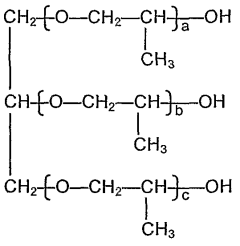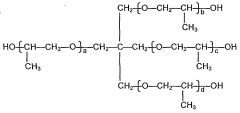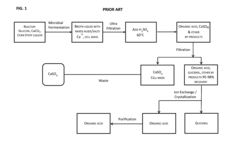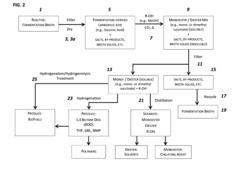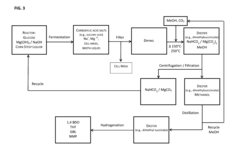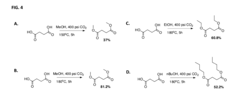Carboxylic Acid's Role in Sustainable Urban Development
JUL 31, 20259 MIN READ
Generate Your Research Report Instantly with AI Agent
Patsnap Eureka helps you evaluate technical feasibility & market potential.
Carboxylic Acid Overview
Carboxylic acids are organic compounds characterized by the presence of a carboxyl group (-COOH) attached to a carbon atom. These versatile molecules play a crucial role in various biological processes and have significant applications in industrial and environmental contexts. In the realm of sustainable urban development, carboxylic acids have emerged as key players due to their unique chemical properties and potential for eco-friendly applications.
The carboxyl group consists of a carbonyl group (C=O) bonded to a hydroxyl group (-OH), giving carboxylic acids their distinctive reactivity and physical properties. These compounds are typically weak acids, capable of donating protons in aqueous solutions. This property makes them valuable in pH regulation and buffer systems, which are essential in many urban environmental applications, such as wastewater treatment and soil remediation.
Carboxylic acids occur naturally in many organic substances, including fruits, vegetables, and animal products. In urban settings, they can be found in various forms, from the acetic acid in vinegar to the fatty acids in biodiesel. Their prevalence in nature and ease of synthesis make them attractive candidates for sustainable urban development initiatives.
One of the most significant roles of carboxylic acids in sustainable urban development is their use in green chemistry applications. As cities strive to reduce their environmental footprint, carboxylic acids offer alternatives to more harmful chemicals in various industrial processes. For instance, citric acid, a tricarboxylic acid, is widely used as an environmentally friendly cleaning agent and food preservative, replacing more toxic synthetic compounds.
In the context of urban waste management, carboxylic acids play a vital role in composting and biodegradation processes. Organic waste, a significant challenge in urban areas, can be efficiently broken down through the action of microorganisms that produce and utilize carboxylic acids. This process not only reduces landfill volume but also generates valuable compost for urban gardening and agriculture.
The potential of carboxylic acids in sustainable energy production is another area of growing interest. Fatty acids, which are long-chain carboxylic acids, serve as precursors for biodiesel production. As cities seek to transition to renewable energy sources, the conversion of waste oils and fats into biodiesel using carboxylic acid chemistry offers a promising avenue for local, sustainable fuel production.
In urban air quality management, carboxylic acids contribute to the formation of secondary organic aerosols, which impact atmospheric chemistry and climate. Understanding the role of these compounds in urban atmospheres is crucial for developing effective air quality control strategies and mitigating the urban heat island effect.
The carboxyl group consists of a carbonyl group (C=O) bonded to a hydroxyl group (-OH), giving carboxylic acids their distinctive reactivity and physical properties. These compounds are typically weak acids, capable of donating protons in aqueous solutions. This property makes them valuable in pH regulation and buffer systems, which are essential in many urban environmental applications, such as wastewater treatment and soil remediation.
Carboxylic acids occur naturally in many organic substances, including fruits, vegetables, and animal products. In urban settings, they can be found in various forms, from the acetic acid in vinegar to the fatty acids in biodiesel. Their prevalence in nature and ease of synthesis make them attractive candidates for sustainable urban development initiatives.
One of the most significant roles of carboxylic acids in sustainable urban development is their use in green chemistry applications. As cities strive to reduce their environmental footprint, carboxylic acids offer alternatives to more harmful chemicals in various industrial processes. For instance, citric acid, a tricarboxylic acid, is widely used as an environmentally friendly cleaning agent and food preservative, replacing more toxic synthetic compounds.
In the context of urban waste management, carboxylic acids play a vital role in composting and biodegradation processes. Organic waste, a significant challenge in urban areas, can be efficiently broken down through the action of microorganisms that produce and utilize carboxylic acids. This process not only reduces landfill volume but also generates valuable compost for urban gardening and agriculture.
The potential of carboxylic acids in sustainable energy production is another area of growing interest. Fatty acids, which are long-chain carboxylic acids, serve as precursors for biodiesel production. As cities seek to transition to renewable energy sources, the conversion of waste oils and fats into biodiesel using carboxylic acid chemistry offers a promising avenue for local, sustainable fuel production.
In urban air quality management, carboxylic acids contribute to the formation of secondary organic aerosols, which impact atmospheric chemistry and climate. Understanding the role of these compounds in urban atmospheres is crucial for developing effective air quality control strategies and mitigating the urban heat island effect.
Urban Sustainability Needs
The rapid urbanization and population growth in cities have led to increasing concerns about sustainability and environmental impact. Urban areas are facing numerous challenges, including air and water pollution, waste management issues, energy consumption, and the need for sustainable infrastructure. In this context, there is a growing demand for innovative solutions that can address these urban sustainability needs while promoting economic growth and improving the quality of life for city dwellers.
One of the key areas of focus in sustainable urban development is the reduction of carbon emissions and the promotion of cleaner energy sources. Cities are major contributors to greenhouse gas emissions, and there is a pressing need for technologies and strategies that can help mitigate climate change impacts. This includes the development of renewable energy systems, energy-efficient buildings, and smart grid technologies that can optimize energy distribution and consumption.
Water management is another critical aspect of urban sustainability. As cities grow, the demand for clean water increases, while water sources become increasingly stressed. There is a need for advanced water treatment technologies, efficient distribution systems, and innovative approaches to water conservation and reuse. Additionally, cities must address the challenges of stormwater management and flood prevention, particularly in the face of climate change-induced extreme weather events.
Waste management is a significant concern for urban areas, with the need for more effective recycling and waste reduction strategies. There is a growing interest in circular economy approaches, where waste materials are reused or repurposed, minimizing the environmental impact of urban consumption patterns. This includes the development of new materials and technologies for waste processing, as well as the implementation of smart waste management systems.
Sustainable transportation is another crucial area for urban sustainability. Cities are looking for ways to reduce traffic congestion, improve air quality, and promote more environmentally friendly modes of transport. This includes the development of electric and hydrogen-powered vehicles, the expansion of public transportation networks, and the creation of infrastructure for cycling and walking.
Green infrastructure and urban biodiversity are increasingly recognized as essential components of sustainable cities. There is a growing demand for solutions that can integrate nature into urban environments, such as green roofs, urban forests, and vertical gardens. These not only improve air quality and reduce the urban heat island effect but also contribute to the overall well-being of city residents.
In addressing these urban sustainability needs, there is a clear opportunity for innovative technologies and approaches that can leverage the properties of carboxylic acids. These compounds have the potential to play a significant role in various aspects of sustainable urban development, from water treatment and air purification to the development of new materials for construction and energy storage.
One of the key areas of focus in sustainable urban development is the reduction of carbon emissions and the promotion of cleaner energy sources. Cities are major contributors to greenhouse gas emissions, and there is a pressing need for technologies and strategies that can help mitigate climate change impacts. This includes the development of renewable energy systems, energy-efficient buildings, and smart grid technologies that can optimize energy distribution and consumption.
Water management is another critical aspect of urban sustainability. As cities grow, the demand for clean water increases, while water sources become increasingly stressed. There is a need for advanced water treatment technologies, efficient distribution systems, and innovative approaches to water conservation and reuse. Additionally, cities must address the challenges of stormwater management and flood prevention, particularly in the face of climate change-induced extreme weather events.
Waste management is a significant concern for urban areas, with the need for more effective recycling and waste reduction strategies. There is a growing interest in circular economy approaches, where waste materials are reused or repurposed, minimizing the environmental impact of urban consumption patterns. This includes the development of new materials and technologies for waste processing, as well as the implementation of smart waste management systems.
Sustainable transportation is another crucial area for urban sustainability. Cities are looking for ways to reduce traffic congestion, improve air quality, and promote more environmentally friendly modes of transport. This includes the development of electric and hydrogen-powered vehicles, the expansion of public transportation networks, and the creation of infrastructure for cycling and walking.
Green infrastructure and urban biodiversity are increasingly recognized as essential components of sustainable cities. There is a growing demand for solutions that can integrate nature into urban environments, such as green roofs, urban forests, and vertical gardens. These not only improve air quality and reduce the urban heat island effect but also contribute to the overall well-being of city residents.
In addressing these urban sustainability needs, there is a clear opportunity for innovative technologies and approaches that can leverage the properties of carboxylic acids. These compounds have the potential to play a significant role in various aspects of sustainable urban development, from water treatment and air purification to the development of new materials for construction and energy storage.
Current Applications
Carboxylic acids play a significant role in various aspects of sustainable urban development, with current applications spanning multiple sectors. In the construction industry, these compounds are utilized in the production of eco-friendly building materials. For instance, carboxylic acid-based additives are incorporated into concrete mixtures to enhance durability and reduce the carbon footprint of structures. This application contributes to the development of more sustainable urban infrastructure with extended lifespans and lower environmental impact.
In urban water treatment systems, carboxylic acids serve as essential components in advanced purification processes. They are employed as chelating agents to remove heavy metals and other contaminants from wastewater, ensuring the efficient recycling of water resources in urban environments. This application is particularly crucial in densely populated areas where water scarcity is a growing concern.
The agricultural sector within urban settings also benefits from carboxylic acid applications. These compounds are used in the formulation of organic pesticides and growth regulators for urban farming initiatives. Rooftop gardens and vertical farms in cities utilize these environmentally friendly solutions to promote sustainable food production without relying on harmful synthetic chemicals.
In the realm of renewable energy, carboxylic acids contribute to the development of advanced energy storage systems. They are used in the production of high-performance electrolytes for next-generation batteries, supporting the integration of renewable energy sources into urban power grids. This application is vital for creating resilient and sustainable energy infrastructure in cities.
Urban air quality management also leverages carboxylic acids in innovative ways. These compounds are employed in the development of air purification systems and photocatalytic coatings for building surfaces. Such applications help reduce air pollution and improve overall air quality in urban environments, contributing to healthier living conditions for city dwellers.
Furthermore, carboxylic acids find applications in sustainable transportation solutions within cities. They are used in the production of biodegradable lubricants and hydraulic fluids for urban vehicle fleets, reducing the environmental impact of transportation systems. Additionally, these compounds play a role in the development of advanced fuel additives that enhance the efficiency and reduce emissions of urban vehicles.
In the field of waste management, carboxylic acids are utilized in the development of biodegradable plastics and packaging materials. This application addresses the growing concern of plastic pollution in urban areas by providing alternatives that can decompose naturally, reducing the burden on landfills and ecosystems.
In urban water treatment systems, carboxylic acids serve as essential components in advanced purification processes. They are employed as chelating agents to remove heavy metals and other contaminants from wastewater, ensuring the efficient recycling of water resources in urban environments. This application is particularly crucial in densely populated areas where water scarcity is a growing concern.
The agricultural sector within urban settings also benefits from carboxylic acid applications. These compounds are used in the formulation of organic pesticides and growth regulators for urban farming initiatives. Rooftop gardens and vertical farms in cities utilize these environmentally friendly solutions to promote sustainable food production without relying on harmful synthetic chemicals.
In the realm of renewable energy, carboxylic acids contribute to the development of advanced energy storage systems. They are used in the production of high-performance electrolytes for next-generation batteries, supporting the integration of renewable energy sources into urban power grids. This application is vital for creating resilient and sustainable energy infrastructure in cities.
Urban air quality management also leverages carboxylic acids in innovative ways. These compounds are employed in the development of air purification systems and photocatalytic coatings for building surfaces. Such applications help reduce air pollution and improve overall air quality in urban environments, contributing to healthier living conditions for city dwellers.
Furthermore, carboxylic acids find applications in sustainable transportation solutions within cities. They are used in the production of biodegradable lubricants and hydraulic fluids for urban vehicle fleets, reducing the environmental impact of transportation systems. Additionally, these compounds play a role in the development of advanced fuel additives that enhance the efficiency and reduce emissions of urban vehicles.
In the field of waste management, carboxylic acids are utilized in the development of biodegradable plastics and packaging materials. This application addresses the growing concern of plastic pollution in urban areas by providing alternatives that can decompose naturally, reducing the burden on landfills and ecosystems.
Sustainable Solutions
01 Synthesis of carboxylic acids
Various methods for synthesizing carboxylic acids are described, including oxidation of primary alcohols or aldehydes, hydrolysis of nitriles, and carbonylation reactions. These processes often involve catalysts and specific reaction conditions to achieve high yields and selectivity.- Synthesis of carboxylic acids: Various methods for synthesizing carboxylic acids are described, including oxidation of primary alcohols or aldehydes, hydrolysis of nitriles, and carbonylation reactions. These processes often involve catalysts and specific reaction conditions to achieve high yields and selectivity.
- Derivatives and applications of carboxylic acids: Carboxylic acids serve as precursors for various derivatives such as esters, amides, and acid chlorides. These compounds find applications in pharmaceuticals, polymers, and industrial processes. The synthesis and properties of these derivatives are explored in several patents.
- Purification and separation techniques: Methods for purifying and separating carboxylic acids from reaction mixtures or natural sources are described. These techniques include crystallization, distillation, extraction, and chromatography, aimed at obtaining high-purity carboxylic acids for various applications.
- Carboxylic acids in polymer chemistry: The use of carboxylic acids in polymer synthesis and modification is explored. This includes their role as monomers in polymerization reactions, crosslinking agents, and surface modifiers for various materials, enhancing properties such as adhesion and durability.
- Environmental and green chemistry aspects: Environmentally friendly processes for producing and using carboxylic acids are described. This includes bio-based production methods, catalytic processes with reduced waste, and applications in biodegradable materials, aligning with principles of green chemistry and sustainability.
02 Carboxylic acid derivatives and applications
Carboxylic acids can be converted into various derivatives such as esters, amides, and anhydrides. These derivatives find applications in pharmaceuticals, polymers, and other industrial processes. The synthesis and properties of these derivatives are explored in several patents.Expand Specific Solutions03 Purification and separation of carboxylic acids
Methods for purifying and separating carboxylic acids from reaction mixtures or natural sources are described. These include crystallization, distillation, extraction, and chromatographic techniques. The focus is on improving purity and yield while reducing energy consumption and waste generation.Expand Specific Solutions04 Carboxylic acids in polymer chemistry
Carboxylic acids play a crucial role in polymer chemistry, serving as monomers or modifiers for various polymeric materials. Patents describe the use of carboxylic acids in the synthesis of polyesters, polyamides, and other functional polymers with specific properties for diverse applications.Expand Specific Solutions05 Green chemistry approaches for carboxylic acids
Environmentally friendly methods for producing and using carboxylic acids are explored. These include bio-based production routes, catalytic processes with reduced waste, and the use of renewable feedstocks. The focus is on developing sustainable alternatives to traditional petrochemical-based processes.Expand Specific Solutions
Key Industry Players
The field of carboxylic acid's role in sustainable urban development is in its early growth stage, with increasing market potential as cities worldwide focus on sustainability. The global market for sustainable urban solutions is expanding rapidly, driven by environmental concerns and regulatory pressures. While the technology is not fully mature, several key players are making significant advancements. Companies like Symrise, Nippon Shokubai, and BASF SE are leading research and development efforts, leveraging their expertise in chemical manufacturing to develop innovative applications. Emerging players such as KZJ New Materials and Sobute New Materials are also contributing to the field, particularly in the context of sustainable construction materials. The involvement of academic institutions like East China Normal University and William Marsh Rice University indicates ongoing fundamental research, suggesting potential for further technological breakthroughs in this area.
Nippon Shokubai Co., Ltd.
Technical Solution: Nippon Shokubai has focused on developing carboxylic acid technologies for sustainable urban applications. Their approach includes the production of superabsorbent polymers based on acrylic acid for use in hygiene products and water management systems in urban areas[1]. They have also developed carboxylic acid-based monomers for low-VOC paints and coatings, contributing to improved air quality in urban environments[2]. Nippon Shokubai's research extends to the use of carboxylic acid derivatives in the production of biodegradable plastics, addressing urban waste management challenges[3]. Additionally, they have introduced carboxylic acid-functionalized materials for improved battery performance, supporting the transition to electric vehicles in cities[4].
Strengths: Leading position in superabsorbent polymer technology, strong presence in Asian markets, and focus on eco-friendly innovations. Weaknesses: Relatively smaller global footprint compared to some competitors, potential exposure to raw material price fluctuations.
Construction Research & Technology GmbH
Technical Solution: Construction Research & Technology GmbH, a subsidiary of BASF, has developed carboxylic acid-based solutions specifically for sustainable urban construction. Their approach includes the use of polycarboxylate ether superplasticizers in concrete admixtures, significantly reducing water requirements and improving workability[1]. This technology enables the production of high-performance concrete with lower cement content, reducing the carbon footprint of urban infrastructure. They have also developed carboxylic acid-modified silanes for waterproofing and protection of concrete structures, enhancing durability in urban environments[2]. Additionally, their research extends to the use of carboxylic acid-based phase change materials for improved thermal management in buildings, contributing to energy efficiency in urban areas[3].
Strengths: Specialized focus on construction industry applications, access to BASF's extensive R&D resources, and strong technical expertise. Weaknesses: Dependence on construction industry cycles, potential challenges in adapting to rapidly changing urban development regulations.
Innovative Research
Carboxylic acid derivatives, method for the production thereof, and use thereof
PatentWO2007048396A2
Innovation
- The use of carboxylic acid derivatives, specifically obtained by reacting unsaturated dicarboxylic anhydrides with hydrophobic reactive components, which are added to cementitious building materials to prevent efflorescence and render them hydrophobic, reducing water absorption and minimizing frost damage and rusting.
Use of carboxylic acids and furanic molecules for esterification
PatentActiveUS20170015643A1
Innovation
- A process that converts carboxylic acids from fermentation broth into their corresponding esters under supercritical or critical conditions in the presence of CO2, eliminating the need for acid catalysts and simplifying downstream processing by recycling by-products back into the fermentation broth.
Environmental Regulations
Environmental regulations play a crucial role in shaping the use and management of carboxylic acids in sustainable urban development. These regulations are designed to protect human health and the environment while promoting sustainable practices in urban areas.
At the international level, agreements such as the Paris Agreement and the United Nations Sustainable Development Goals provide a framework for addressing climate change and promoting sustainable development. These agreements influence national and local policies regarding the use of chemicals, including carboxylic acids, in urban environments.
In the European Union, the REACH (Registration, Evaluation, Authorization, and Restriction of Chemicals) regulation governs the production, import, and use of chemical substances, including carboxylic acids. This regulation requires companies to register chemicals and provide safety information, ensuring that potentially harmful substances are properly managed.
The United States Environmental Protection Agency (EPA) regulates carboxylic acids under various acts, including the Clean Air Act and the Toxic Substances Control Act. These regulations set limits on emissions and require reporting of chemical use and disposal practices.
Many countries have implemented specific regulations for the use of carboxylic acids in urban settings. For example, some cities have restrictions on the use of certain carboxylic acids in cleaning products to reduce water pollution and protect aquatic ecosystems.
In the context of sustainable urban development, regulations often focus on promoting the use of environmentally friendly alternatives to traditional chemical products. This includes encouraging the use of bio-based carboxylic acids derived from renewable resources, as well as supporting research into green chemistry applications.
Waste management regulations also impact the use of carboxylic acids in urban environments. Many jurisdictions have strict guidelines for the disposal of chemical waste, including requirements for proper treatment and recycling of carboxylic acid-containing products.
As urban areas increasingly prioritize sustainability, regulations are evolving to address emerging concerns. For instance, some cities are implementing regulations to promote the use of carboxylic acids in green building materials and sustainable infrastructure projects.
The regulatory landscape for carboxylic acids in sustainable urban development is complex and dynamic. As new scientific evidence emerges and societal priorities shift, regulations continue to adapt to balance economic development with environmental protection and public health concerns.
At the international level, agreements such as the Paris Agreement and the United Nations Sustainable Development Goals provide a framework for addressing climate change and promoting sustainable development. These agreements influence national and local policies regarding the use of chemicals, including carboxylic acids, in urban environments.
In the European Union, the REACH (Registration, Evaluation, Authorization, and Restriction of Chemicals) regulation governs the production, import, and use of chemical substances, including carboxylic acids. This regulation requires companies to register chemicals and provide safety information, ensuring that potentially harmful substances are properly managed.
The United States Environmental Protection Agency (EPA) regulates carboxylic acids under various acts, including the Clean Air Act and the Toxic Substances Control Act. These regulations set limits on emissions and require reporting of chemical use and disposal practices.
Many countries have implemented specific regulations for the use of carboxylic acids in urban settings. For example, some cities have restrictions on the use of certain carboxylic acids in cleaning products to reduce water pollution and protect aquatic ecosystems.
In the context of sustainable urban development, regulations often focus on promoting the use of environmentally friendly alternatives to traditional chemical products. This includes encouraging the use of bio-based carboxylic acids derived from renewable resources, as well as supporting research into green chemistry applications.
Waste management regulations also impact the use of carboxylic acids in urban environments. Many jurisdictions have strict guidelines for the disposal of chemical waste, including requirements for proper treatment and recycling of carboxylic acid-containing products.
As urban areas increasingly prioritize sustainability, regulations are evolving to address emerging concerns. For instance, some cities are implementing regulations to promote the use of carboxylic acids in green building materials and sustainable infrastructure projects.
The regulatory landscape for carboxylic acids in sustainable urban development is complex and dynamic. As new scientific evidence emerges and societal priorities shift, regulations continue to adapt to balance economic development with environmental protection and public health concerns.
Economic Feasibility
The economic feasibility of incorporating carboxylic acids in sustainable urban development hinges on several key factors. Firstly, the production costs of carboxylic acids must be considered. While some carboxylic acids can be derived from renewable resources, such as biomass or waste streams, others may require more expensive synthetic processes. The scalability of production methods directly impacts the overall economic viability of their use in urban development projects.
Infrastructure requirements for the implementation of carboxylic acid-based solutions in urban settings also play a crucial role in determining economic feasibility. This includes storage facilities, transportation systems, and application equipment. The initial investment in such infrastructure can be substantial, but may be offset by long-term benefits and cost savings.
The potential for cost savings through the use of carboxylic acids in sustainable urban development is significant. For instance, their application in green building materials can lead to improved energy efficiency, reducing long-term operational costs. Additionally, carboxylic acids used in water treatment processes can enhance efficiency and reduce the need for more expensive chemical treatments.
Market demand for sustainable urban solutions incorporating carboxylic acids is another critical economic factor. As cities increasingly prioritize sustainability, the demand for eco-friendly materials and processes is growing. This trend can drive economies of scale, potentially lowering production costs and improving overall economic feasibility.
Regulatory frameworks and incentives also impact the economic viability of carboxylic acid applications in urban development. Government policies promoting sustainable practices, such as tax incentives or grants for green building projects, can significantly improve the economic attractiveness of carboxylic acid-based solutions.
The potential for job creation and economic growth in related industries should not be overlooked. The development and implementation of carboxylic acid technologies in urban settings can stimulate innovation, create new employment opportunities, and contribute to local economic development.
Lastly, the long-term economic benefits of sustainable urban development using carboxylic acids must be weighed against short-term costs. While initial investments may be higher, the potential for reduced environmental impact, improved resource efficiency, and enhanced urban resilience can lead to substantial economic advantages over time. This long-term perspective is crucial when assessing the overall economic feasibility of integrating carboxylic acids into sustainable urban development strategies.
Infrastructure requirements for the implementation of carboxylic acid-based solutions in urban settings also play a crucial role in determining economic feasibility. This includes storage facilities, transportation systems, and application equipment. The initial investment in such infrastructure can be substantial, but may be offset by long-term benefits and cost savings.
The potential for cost savings through the use of carboxylic acids in sustainable urban development is significant. For instance, their application in green building materials can lead to improved energy efficiency, reducing long-term operational costs. Additionally, carboxylic acids used in water treatment processes can enhance efficiency and reduce the need for more expensive chemical treatments.
Market demand for sustainable urban solutions incorporating carboxylic acids is another critical economic factor. As cities increasingly prioritize sustainability, the demand for eco-friendly materials and processes is growing. This trend can drive economies of scale, potentially lowering production costs and improving overall economic feasibility.
Regulatory frameworks and incentives also impact the economic viability of carboxylic acid applications in urban development. Government policies promoting sustainable practices, such as tax incentives or grants for green building projects, can significantly improve the economic attractiveness of carboxylic acid-based solutions.
The potential for job creation and economic growth in related industries should not be overlooked. The development and implementation of carboxylic acid technologies in urban settings can stimulate innovation, create new employment opportunities, and contribute to local economic development.
Lastly, the long-term economic benefits of sustainable urban development using carboxylic acids must be weighed against short-term costs. While initial investments may be higher, the potential for reduced environmental impact, improved resource efficiency, and enhanced urban resilience can lead to substantial economic advantages over time. This long-term perspective is crucial when assessing the overall economic feasibility of integrating carboxylic acids into sustainable urban development strategies.
Unlock deeper insights with Patsnap Eureka Quick Research — get a full tech report to explore trends and direct your research. Try now!
Generate Your Research Report Instantly with AI Agent
Supercharge your innovation with Patsnap Eureka AI Agent Platform!


